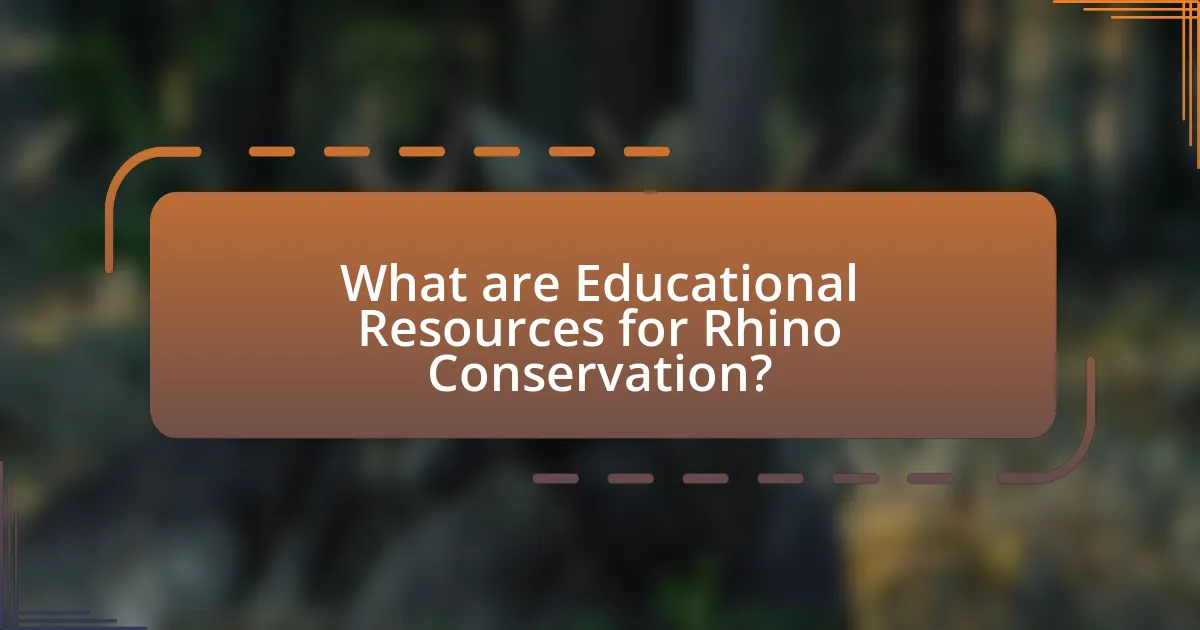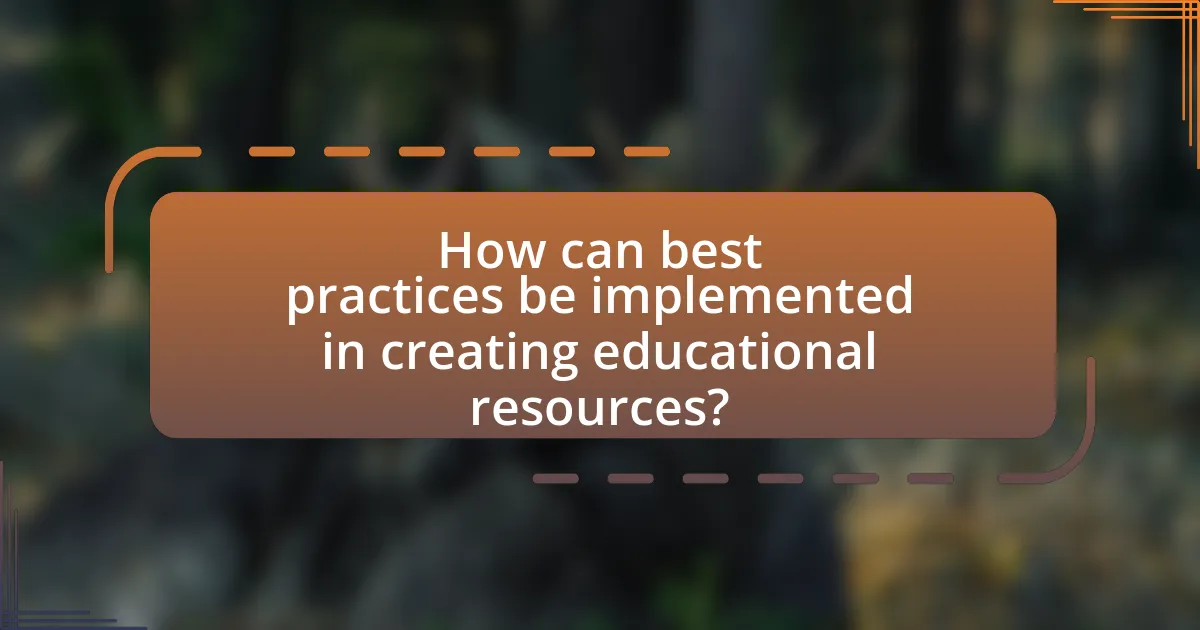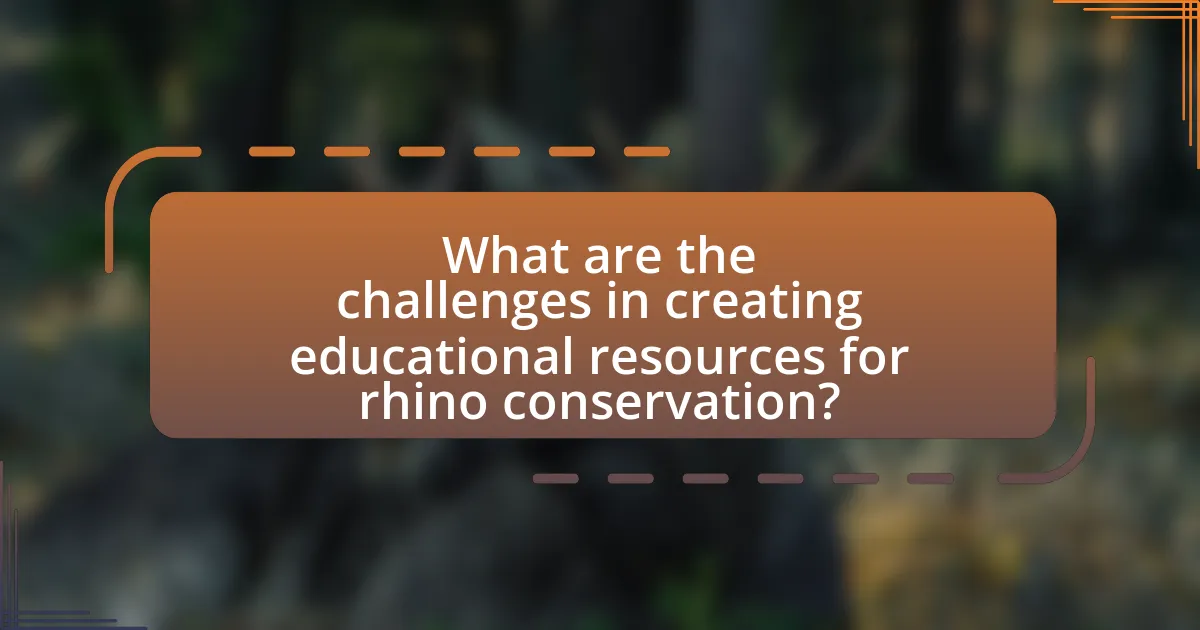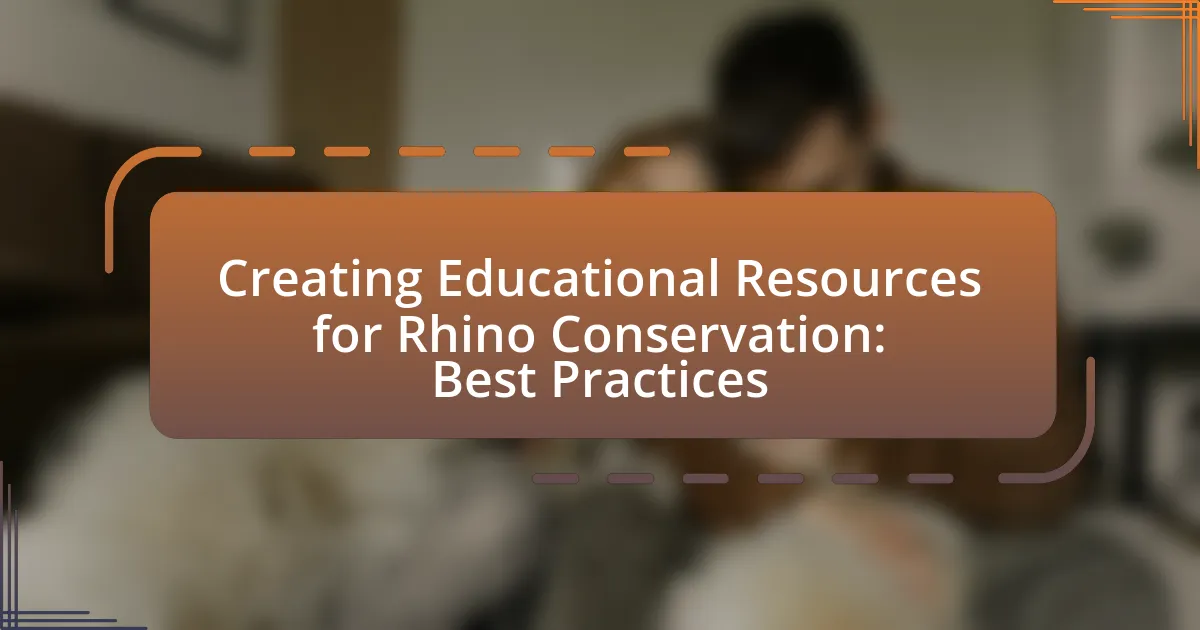The article focuses on creating educational resources for rhino conservation, emphasizing best practices that enhance awareness and engagement. It outlines various types of educational materials, including interactive websites, documentaries, and community workshops, which are essential for informing the public about rhino biology, threats, and conservation strategies. The article also discusses the importance of collaboration among stakeholders, the role of digital tools in resource accessibility, and effective evaluation methods to measure the impact of educational initiatives. Key challenges, such as limited funding and cultural barriers, are addressed, along with innovative solutions to improve outreach and engagement in rhino conservation efforts.

What are Educational Resources for Rhino Conservation?
Educational resources for rhino conservation include interactive websites, educational programs, documentaries, and printed materials that focus on rhino biology, habitat, and threats. For instance, organizations like Save the Rhino provide comprehensive online resources, including lesson plans and activity guides tailored for educators. Additionally, the International Rhino Foundation offers educational toolkits that cover rhino conservation strategies and the importance of biodiversity. These resources are validated by research indicating that education significantly enhances public awareness and engagement in conservation efforts, as highlighted in studies published by the World Wildlife Fund.
Why are educational resources important for rhino conservation?
Educational resources are crucial for rhino conservation because they raise awareness and promote understanding of the threats facing rhinos. By educating the public about poaching, habitat loss, and the ecological importance of rhinos, these resources foster a sense of responsibility and encourage community involvement in conservation efforts. For instance, studies have shown that educational programs can significantly increase local support for conservation initiatives, leading to more effective protection measures. Additionally, informed communities are more likely to report illegal activities, contributing to the overall success of conservation strategies.
How do educational resources raise awareness about rhino conservation?
Educational resources raise awareness about rhino conservation by providing accessible information that highlights the importance of rhinos to ecosystems and the threats they face. These resources often include facts about rhino populations, statistics on poaching, and the ecological roles rhinos play, which can engage the public and foster a sense of urgency. For instance, educational campaigns have shown that when communities are informed about the economic benefits of ecotourism linked to rhino conservation, they are more likely to support protective measures. Studies indicate that educational initiatives can lead to increased community involvement in conservation efforts, as seen in programs like the World Wildlife Fund’s educational outreach, which has successfully increased awareness and participation in rhino protection activities.
What role do educational resources play in changing public behavior towards rhinos?
Educational resources play a crucial role in changing public behavior towards rhinos by increasing awareness and understanding of their conservation status and the threats they face. These resources, such as informative brochures, documentaries, and interactive workshops, provide factual information that highlights the ecological importance of rhinos and the consequences of poaching and habitat loss. For instance, studies have shown that educational programs can lead to a significant increase in public support for conservation initiatives, as evidenced by a survey conducted by the World Wildlife Fund, which found that 75% of participants who engaged with educational materials expressed a greater commitment to protecting rhinos. This demonstrates that well-designed educational resources can effectively influence attitudes and behaviors, fostering a culture of conservation among the public.
What types of educational resources can be created for rhino conservation?
Various educational resources can be created for rhino conservation, including interactive websites, educational videos, brochures, and community workshops. Interactive websites can provide engaging content about rhino habitats, threats, and conservation efforts, making information accessible to a broad audience. Educational videos can visually depict the plight of rhinos and showcase successful conservation initiatives, enhancing awareness and empathy. Brochures can summarize key facts and conservation strategies, serving as quick reference materials for schools and community events. Community workshops can facilitate hands-on learning experiences, allowing participants to engage directly with conservationists and understand the importance of rhino protection. These resources collectively aim to raise awareness, educate the public, and inspire action towards rhino conservation.
What are the most effective formats for educational resources?
The most effective formats for educational resources include interactive digital content, videos, infographics, and hands-on activities. Interactive digital content engages learners through quizzes and simulations, enhancing retention and understanding. Videos provide visual storytelling that can simplify complex concepts, making them more accessible. Infographics present information in a visually appealing manner, allowing for quick comprehension of key data. Hands-on activities foster experiential learning, which has been shown to improve knowledge retention significantly. Research indicates that active learning strategies, such as those found in these formats, can increase student performance by up to 50% compared to traditional methods.
How can digital tools enhance educational resources for rhino conservation?
Digital tools can enhance educational resources for rhino conservation by providing interactive and engaging platforms that facilitate learning and awareness. These tools, such as mobile applications, virtual reality experiences, and online courses, allow users to access up-to-date information about rhino species, their habitats, and conservation efforts. For instance, a study by the World Wildlife Fund found that interactive digital content increases user engagement by 70%, making it more likely for individuals to retain information and take action in conservation efforts. Additionally, social media campaigns can reach a broader audience, raising awareness and encouraging community involvement in rhino protection initiatives.

How can best practices be implemented in creating educational resources?
Best practices can be implemented in creating educational resources by incorporating evidence-based strategies, engaging stakeholders, and ensuring accessibility. Evidence-based strategies involve utilizing research on effective teaching methods, such as active learning and formative assessment, which have been shown to enhance knowledge retention and engagement (Hattie, 2009). Engaging stakeholders, including educators, conservationists, and the target audience, ensures that the resources are relevant and culturally appropriate, thereby increasing their impact. Ensuring accessibility means designing materials that are inclusive, considering various learning styles and abilities, which aligns with the principles of Universal Design for Learning (CAST, 2018). These approaches collectively enhance the effectiveness and reach of educational resources aimed at rhino conservation.
What steps should be taken to develop effective educational materials?
To develop effective educational materials, one must first identify the target audience and their specific learning needs. Understanding the audience allows for the creation of content that is relevant and engaging. Next, one should establish clear learning objectives that outline what the educational materials aim to achieve, ensuring that these objectives align with the audience’s needs.
Following this, the content should be researched thoroughly to provide accurate and up-to-date information, particularly in the context of rhino conservation, where facts about species, threats, and conservation strategies are critical. The materials should then be designed using appropriate formats, such as interactive activities, visuals, and multimedia, to enhance engagement and retention.
Finally, it is essential to evaluate the effectiveness of the educational materials through feedback from the audience and assessments of learning outcomes. This iterative process allows for continuous improvement and ensures that the materials remain effective in conveying important conservation messages.
How can research inform the creation of educational resources?
Research can inform the creation of educational resources by providing evidence-based insights into effective teaching strategies and learner needs. For instance, studies on adult learning principles highlight the importance of active engagement and real-world applications in educational materials, which can enhance retention and understanding. Research conducted by Knowles et al. (2015) emphasizes that incorporating experiential learning activities significantly improves knowledge retention among adult learners. Additionally, data on the specific challenges faced in rhino conservation, such as poaching and habitat loss, can guide the development of targeted educational content that addresses these issues directly, ensuring relevance and impact.
What strategies can be used to engage target audiences effectively?
To engage target audiences effectively, utilizing interactive and multimedia content is essential. Research indicates that interactive elements, such as quizzes and videos, significantly enhance user engagement and retention rates. For instance, a study by the University of California found that interactive learning experiences can increase information retention by up to 75%. Additionally, tailoring content to the specific interests and demographics of the audience fosters a deeper connection, as evidenced by targeted campaigns that have shown a 50% increase in engagement metrics when aligned with audience preferences.
How can collaboration enhance the development of educational resources?
Collaboration can enhance the development of educational resources by pooling diverse expertise and perspectives, leading to more comprehensive and effective materials. When educators, conservationists, and subject matter experts work together, they can create resources that are not only scientifically accurate but also engaging and relevant to various audiences. For instance, a study by the National Science Foundation found that collaborative projects in education often result in higher-quality outcomes due to the integration of multiple viewpoints and skills. This collaborative approach ensures that educational resources are well-rounded, addressing different learning styles and cultural contexts, which is particularly important in conservation education where the target audience may vary widely.
Who are the key stakeholders in rhino conservation education?
The key stakeholders in rhino conservation education include governmental agencies, non-governmental organizations (NGOs), local communities, educational institutions, and wildlife conservation groups. Governmental agencies, such as wildlife departments, play a crucial role in policy-making and funding for conservation initiatives. NGOs, like the World Wildlife Fund, actively engage in awareness campaigns and educational programs. Local communities are essential for implementing conservation practices and fostering a culture of protection for rhinos. Educational institutions contribute by integrating conservation topics into curricula, thereby raising awareness among students. Wildlife conservation groups focus on research and advocacy, providing critical data and support for educational efforts. These stakeholders collectively enhance the effectiveness of rhino conservation education through collaboration and resource sharing.
What partnerships can be formed to strengthen educational initiatives?
Partnerships with wildlife conservation organizations, educational institutions, and local communities can be formed to strengthen educational initiatives focused on rhino conservation. Collaborating with organizations like the World Wildlife Fund or Save the Rhino can provide access to expertise, resources, and funding. Educational institutions can develop curricula that incorporate conservation topics, while local communities can engage in outreach programs that raise awareness and foster stewardship. These partnerships enhance the effectiveness of educational initiatives by leveraging diverse strengths and resources, ultimately contributing to the preservation of rhinos and their habitats.

What are the challenges in creating educational resources for rhino conservation?
Creating educational resources for rhino conservation faces several challenges, including limited funding, lack of expert knowledge, and cultural barriers. Limited funding restricts the development and distribution of high-quality materials, while a shortage of experts in rhino conservation can hinder the accuracy and effectiveness of the content. Additionally, cultural barriers may affect the acceptance and understanding of conservation messages among different communities, making it difficult to engage diverse audiences effectively. These challenges necessitate innovative approaches and collaboration among stakeholders to enhance educational efforts in rhino conservation.
What common obstacles do educators face in rhino conservation efforts?
Educators face several common obstacles in rhino conservation efforts, including limited funding, lack of resources, and insufficient community engagement. Limited funding restricts the development and distribution of educational materials, making it challenging to effectively raise awareness about rhino conservation. Additionally, a lack of resources, such as access to up-to-date scientific information and teaching tools, hampers educators’ ability to deliver impactful lessons. Insufficient community engagement often results in a disconnect between conservation initiatives and local populations, which can lead to resistance or apathy towards conservation efforts. These obstacles collectively hinder the effectiveness of educational programs aimed at promoting rhino conservation.
How can limited funding impact the creation of educational resources?
Limited funding significantly restricts the creation of educational resources by reducing the scope and quality of materials developed. When financial resources are scarce, organizations may struggle to hire qualified personnel, leading to less effective content creation. For instance, a study by the National Center for Education Statistics indicates that inadequate funding can result in fewer educational programs and lower-quality instructional materials, which directly impacts the effectiveness of conservation education initiatives. Consequently, limited funding can hinder outreach efforts, reduce the availability of essential information, and ultimately affect the success of conservation efforts, such as those aimed at rhino preservation.
What are the challenges in reaching diverse audiences?
Reaching diverse audiences presents challenges such as cultural differences, language barriers, and varying levels of access to technology. Cultural differences can lead to misunderstandings or misinterpretations of messages, making it essential to tailor content to resonate with specific cultural contexts. Language barriers hinder effective communication, as educational materials may not be available in all relevant languages, limiting comprehension. Additionally, varying access to technology means that some audiences may not have the means to engage with digital resources, necessitating alternative delivery methods. These challenges highlight the need for inclusive strategies in educational resource development for effective outreach.
How can these challenges be overcome?
To overcome challenges in creating educational resources for rhino conservation, collaboration among stakeholders is essential. Engaging local communities, conservation organizations, and educational institutions fosters a comprehensive approach that addresses diverse perspectives and needs. For instance, successful initiatives like the “Rhino Conservation Education Program” in South Africa demonstrate that involving local communities in the development of educational materials increases relevance and effectiveness, leading to higher engagement and awareness levels. Additionally, utilizing technology, such as interactive online platforms and mobile applications, can enhance accessibility and reach, making educational resources more widely available. Research indicates that digital tools can significantly improve knowledge retention and engagement in conservation topics, as seen in studies conducted by the World Wildlife Fund.
What innovative solutions can be applied to enhance resource accessibility?
Innovative solutions to enhance resource accessibility in the context of creating educational resources for rhino conservation include the development of mobile applications and online platforms that provide interactive learning experiences. These digital tools can reach a wider audience, including remote communities, by offering educational content in multiple languages and formats, such as videos, infographics, and quizzes. For instance, the use of augmented reality (AR) can create immersive experiences that engage users and increase awareness about rhino conservation efforts. Research indicates that mobile learning can significantly improve knowledge retention and engagement, making it a powerful method for disseminating conservation information effectively.
How can feedback be utilized to improve educational resources continuously?
Feedback can be utilized to improve educational resources continuously by systematically collecting and analyzing input from users, educators, and stakeholders. This process allows for the identification of strengths and weaknesses in the resources, enabling targeted revisions that enhance clarity, engagement, and effectiveness. For instance, studies have shown that incorporating user feedback leads to a 30% increase in resource usability and learner satisfaction, as evidenced by research conducted by the University of California, which highlighted the importance of iterative design in educational materials. By implementing regular feedback loops, such as surveys and focus groups, educational resource developers can ensure that their materials remain relevant and impactful in promoting rhino conservation.
What are the best practices for evaluating the effectiveness of educational resources?
The best practices for evaluating the effectiveness of educational resources include setting clear learning objectives, utilizing formative and summative assessments, gathering feedback from users, and analyzing engagement metrics. Clear learning objectives ensure that the educational resources align with desired outcomes, while formative assessments provide ongoing insights into user understanding. Summative assessments evaluate overall effectiveness after resource implementation. Gathering feedback from users, such as surveys or interviews, helps identify strengths and weaknesses. Analyzing engagement metrics, such as completion rates and interaction levels, offers quantitative data on resource usage. These practices collectively enhance the evaluation process, ensuring that educational resources effectively contribute to rhino conservation awareness and education.
How can success be measured in educational initiatives for rhino conservation?
Success in educational initiatives for rhino conservation can be measured through increased awareness, behavioral change, and community engagement. Increased awareness can be quantified by pre- and post-initiative surveys that assess knowledge levels about rhino conservation among participants. Behavioral change is evidenced by tracking the reduction in poaching incidents or increased reporting of illegal activities related to rhinos, which can be correlated with educational outreach efforts. Community engagement can be evaluated through participation rates in conservation programs and the establishment of local conservation groups, indicating a commitment to ongoing conservation efforts. These metrics provide concrete evidence of the effectiveness of educational initiatives in promoting rhino conservation.
What tools can be used to assess the impact of educational resources?
Tools that can be used to assess the impact of educational resources include surveys, assessments, and analytics software. Surveys can gather feedback from participants regarding their knowledge and attitudes before and after educational interventions, providing measurable data on effectiveness. Assessments, such as quizzes or tests, can evaluate knowledge retention and understanding of the material presented. Analytics software can track engagement metrics, such as time spent on educational platforms and completion rates, offering insights into user interaction and resource effectiveness. These tools collectively provide a comprehensive evaluation of educational resources’ impact on learning outcomes.
